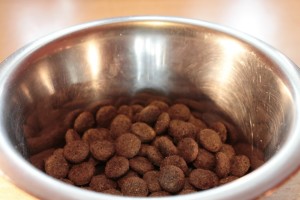Spring has arrived, bringing warm, sunny weather, lovely flowers, and… yes, fleas. A flea life span is 90 days and a single flea can lay as many as 60 eggs per day. This alone may seem like a nightmare, but a hibernating cocoon will survive up to a year without feeding. As if I couldn’t freak you out any more, like cockroaches, fleas adapt to their environment, becoming stronger and more immune to popular commercial flea control methods with each new generation. Lastly, the climax of this horrible reality is that most fleas live throughout their host’s environment — meaning that if you find one flea on your pet there are approximately 30 more living in your home. The warming spring temperature cues hundreds of fleas to burst through their egg shells and begin their hunt for a host. I am going to discuss three homeopathic methods of preventing your fur baby from becoming a flea buffet.
One home remedy is mixing common cooking products into your pet’s food and water to change the taste of their blood. Apple cider vinegar is a natural deterrent of fleas and helps strengthen your pet’s immune system. One teaspoon daily in your pet’s drinking water will do the trick to ward off fleas. Brewer’s or nutritional yeast is another option. Using one teaspoon of unprocessed brewer’s or nutritional yeast daily will work for cats and small dogs. For pets over 50 pounds, it’s recommended to use one tablespoon daily. WARNING: Some animals may be yeast intolerant and will react with a skin allergy. Discontinue use if this occurs. Lastly, like yeast, fleas are particularly disgusted by garlic. However, as little as one clove of raw garlic can cause toxicity in cats and some breeds of dogs. Before trying any of the above, make sure to consult your vet first to ensure your pet’s health and safety.
Another organic method is diatomaceous earth, which can be applied throughout your home and on your pet. Prior to application, it is very important to sanitize your pet’s environment. This entails thoroughly vacuuming all cloth surfaces including carpet, drapes and furniture and frequently washing your pet’s bedding. Remember to promptly dispose of vacuum bag/contents outside of your home and replace with a new bag or wash bagless container. Afterward, apply small amounts of DE in places where fleas are most seen: pets’ bedding, couch, all floors, under the baseboard heater, near the sink, and in the cupboards. While DE is a lethal dust with microscopic razor-sharp edges to insects, it is harmless to humans and pets. You can even rub DE into your pet’s fur to keep the fleas at bay.
Lastly, nematodes are microscopic worms that naturally exist in the ground and are a predator to the flea larvae. You can also purchase nematodes at some pet and garden stores. Most commonly applied with a lawn spreader, placing these worms in moist shaded areas near your home can reduce the resident flea population up to 80 percent within 24 hours of application. An added bonus is that nematodes multiply rapidly, meaning introducing a small initial number will create residual benefits for weeks to come. Extreme temperatures, both hot and cold, kill nematodes so it may be necessary to re-apply after such occurrence.
In conclusion, as the ground is thawing and new life is emerging, we must become proactive in stopping fleas from turning our fur babies into an all-you-can-eat buffet. Each new generation of flea is adapting to the latest most popular chemical flea bomb and their strength is growing. These timeless home remedies I have discussed above are superior to the toxic chemical cocktails, for these homeopathic methods get down to the flea’s core existence. These remedies are using nature to fight nature. Therefore, this spring as our pets are spending more time playing in the sun and frolicking through the green grass, we will know they are safely protected from the nasty parasitic fleas.






Thanks, Audry. Fleas are a nightmare. I like the apple cider remedy – I will take it “myself” to detour fleas. I have had a lot of problems with my little “fosters,” coming into my care – covered in fleas. I’m allergic to them, and it is sad that I am unable to foster more often because of “fleas.”
New Hope
Your very Welcome New Hope. I also thought I would mention a certain type of flea shampoo that is all natural and can be used on the youngest of fosters ( I use this Product on my own fosters when they come in covered in fleas). It is Natural Chemistry brand and is called Natural Flea shampoo for cats of all ages. This Shampoo not only kills the fleas (if used as directed on bottle) But also helps keep new fleas off for up to 7 days. I’m glad you enjoyed the article, please feel free to visit my Facebook page http://www.facebook.com/AudiesAngelsPetCare. Have a blessed day Audrey Lohrey- Audies Angels